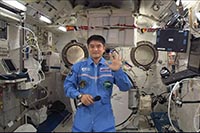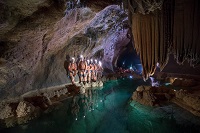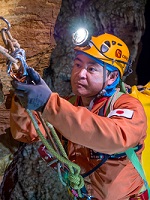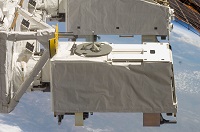This is an archive of information released in the past.
Disclaimer: It may contain broken links or outdated information. Some parts may not function in current web browsers.
*Visit https://humans-in-space.jaxa.jp/en/ for the latest information.

ISS/Kibo Monthly News
ISS/Kibo Monthly News: July, 2016
Topic of the Month
Astronaut Takuya Onishi commences his ISS Expedition mission
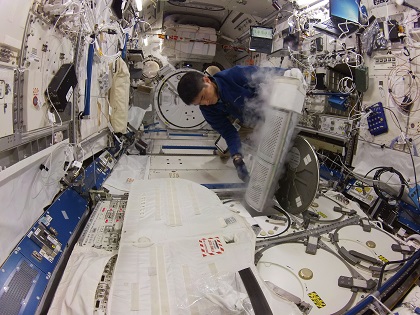
Onishi storing medical samples in the Minus Eighty degree Celsius
Laboratory Freezer for ISS (MELFI)
(July 18. Credit: JAXA/NASA/Takuya Onishi)
At 10:36 a.m. on July 7, the International Space Station (ISS) Expedition 48/49 crew including Astronaut Takuya Onishi was launched aboard the Soyuz MS-01 spacecraft (47S) from the Baikonur Cosmodrome in Kazakhstan.
Within nine minutes from the launch, following the third-stage engine cutoff, the Soyuz spacecraft was separated and then entered orbit. Following repetitive orbital maneuvers on July 9, the spacecraft then docked with the Rassvet (Mini-Research Module 1: MRM1) at 1:06 p.m. over the South Pacific Ocean, just off the coast of Chile.
After checking for any leaks between the Soyuz spacecraft and the ISS, the crew entered the ISS at 3:53 p.m. After receiving a warm welcome from ISS Commander Jeffrey Williams and the onboard crew, the newcomers communicated with the ground.
As Saturday and Sunday are basically holidays on the ISS, Onishi began his work on Monday, July 11, and is engaged in experiments and maintenance tasks.
On the ISS, extensive biomedical research is being conducted to study physiological changes caused by a long-term stay under microgravity. Onishi also measured his blood stream, and obtained blood and urine samples.
Onishi also underwent onboard training on the Space Station Remote Manipulator System (SSRMS). Unlike using a simulator in training on the ground, he practiced using the actual SSRMS for the first time.
On July 19, he attended the onboard press conference connecting the ISS and the JAXA Tokyo office. In response to questions received from the reporters (with about 50 news people in attendance), Onishi discussed the meaning of staying in space and his aspirations for the mission.
JAXA Astronauts This Month
Astronaut Akihiko Hoshide completes ESA CAVES training
In early July, Astronaut Akihiko Hoshide participated in the Cooperative Adventure for Valuing and Exercising human behaviour and performance Skills (CAVES) along with astronauts from NASA, Roscosmos, the European Space Agency (ESA), and China, which was held in a cave located 800 meters underground on the island of Sardinia, Italy.
During the week-long training, the participants explored the cave for conducting a survey, mapping and a geological investigation, harvesting biological samples, and photographing. CAVES is intended to improve the skills required for long-duration missions on the ISS, such as leadership, followership, teamwork, and decision making in a multinational team.
Kibo this Month
Results of JAXA experiments receive ISS Research Awards
In July, the results of JAXA experiments were recognized by receiving the 2016 ISS Research Award--"Space Station Top Results for Discoveries" during the ISS R&D Conference held in San Diego, California.
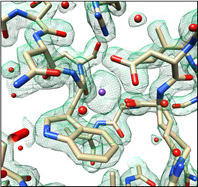
Electron density map of peptide-degrading enzyme DPP11 (Credit: Yasumitsu Sakamoto, Iwate Medical University)
Of the two JAXA experiment themes that have been awarded, one is the result of Protein Crystal Growth (JAXA PCG).
Based on the crystals grown in Kibo, the detailed 3D conformation of peptide-degrading enzyme DPP11 that is important for the growth of periodontal disease bacteria has been identified for the first time ever.
A drug that inhibits the function of enzyme DPP11 in degrading peptides (polymers of amino acids linked by amide bonds) blocks the absorption of nutrition into periodontal disease bacteria, and thus can be a candidate drug for treating periodontal disease. In addition, the result will hopefully lead to the development of a new antibacterial drug for multi-drug resistant bacteria.
Another award given to Japan was in recognition of the findings obtained by the Monitor of All-sky X-ray Image (MAXI). Since August 2009, MAXI has been monitoring X-rays in the universe and contributing to the advancement of X-ray astronomy, which has made such world-class discoveries as a black hole candidate and an X-ray binary pulsar. Such results were published in scientific journals including Nature.
Candidates for the ISS Research Award are nominated by NASA, the Center for the Advancement of Science in Space (CASIS), and International Partners (IP), undergo a selection process conducted by the American Astronomical Society (AAS), and then the winners are announced at the ISS R&D Conference.
ISS this Month
Dragon spacecraft carries the International Docking Adapter to the ISS
On July 18, the Dragon spacecraft (SpaceX CRS-9) was launched from the Cape Canaveral Air Force Station in Florida.
On July 20, NASA Astronauts Jeffrey Williams and Kathleen Rubins used the SSRMS to capture the Dragon spacecraft, which was then berthed with the ISS.
The Dragon spacecraft carried about 1,790 kg of pressurized cargo and the second International Docking Adapter (IDA-2) in its exposed trunk. IDA-2 is a docking adapter used between the ISS and spacecraft; it is built in compliance with the International Docking System Standard (IDSS) to enable the docking of future spacecraft equipped with a uniform docking mechanism.
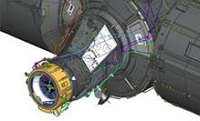
An image of Node 2 with IDA-2 installed (Credit: JAXA/NASA)
IDA-2 will be installed to Harmony (Node 2), the docking port of Space Shuttles in the past. An extravehicular activity (EVA) will be conducted for IDA-2 installation and preparations have already been made, such as routing cable inside and outside the ISS.
| Copyright 2007 Japan Aerospace Exploration Agency | Site Policy |


